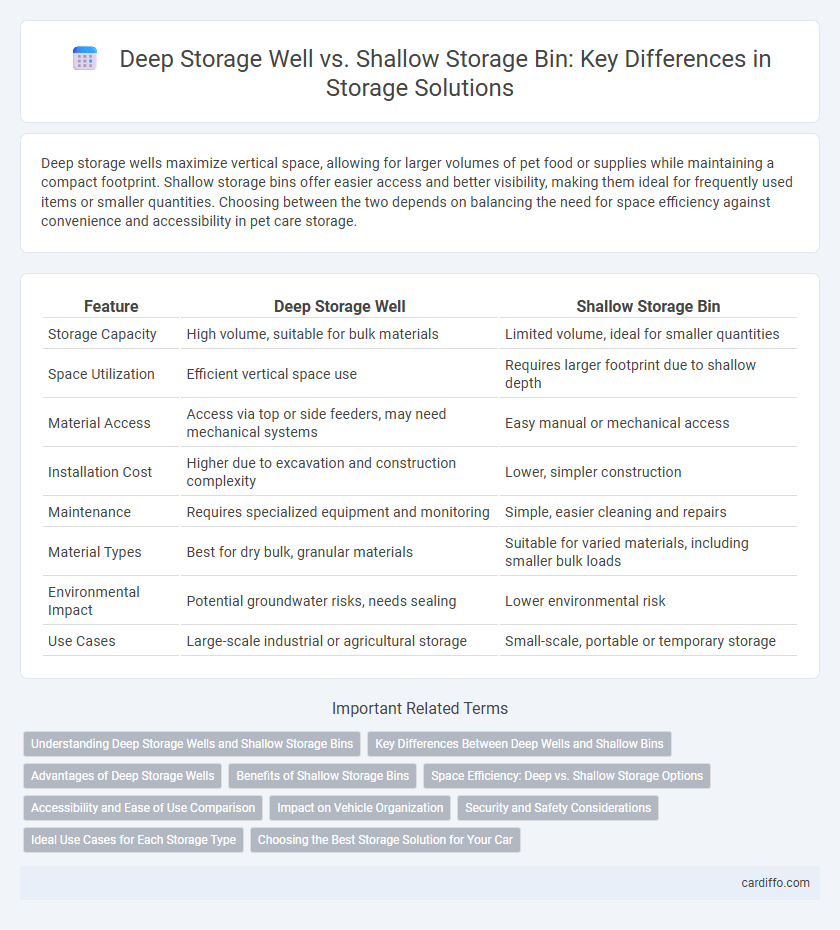Deep storage wells maximize vertical space, allowing for larger volumes of pet food or supplies while maintaining a compact footprint. Shallow storage bins offer easier access and better visibility, making them ideal for frequently used items or smaller quantities. Choosing between the two depends on balancing the need for space efficiency against convenience and accessibility in pet care storage.
Table of Comparison
| Feature | Deep Storage Well | Shallow Storage Bin |
|---|---|---|
| Storage Capacity | High volume, suitable for bulk materials | Limited volume, ideal for smaller quantities |
| Space Utilization | Efficient vertical space use | Requires larger footprint due to shallow depth |
| Material Access | Access via top or side feeders, may need mechanical systems | Easy manual or mechanical access |
| Installation Cost | Higher due to excavation and construction complexity | Lower, simpler construction |
| Maintenance | Requires specialized equipment and monitoring | Simple, easier cleaning and repairs |
| Material Types | Best for dry bulk, granular materials | Suitable for varied materials, including smaller bulk loads |
| Environmental Impact | Potential groundwater risks, needs sealing | Lower environmental risk |
| Use Cases | Large-scale industrial or agricultural storage | Small-scale, portable or temporary storage |
Understanding Deep Storage Wells and Shallow Storage Bins
Deep storage wells are subterranean reservoirs designed for long-term containment of large volumes of gases or liquids, offering high stability and minimal surface footprint. Shallow storage bins, typically located near the surface, facilitate easier access and quicker retrieval but have limited capacity and are more vulnerable to environmental factors. Understanding the trade-offs between deep storage wells and shallow storage bins is critical for optimizing storage solutions based on capacity requirements, safety, and operational efficiency.
Key Differences Between Deep Wells and Shallow Bins
Deep storage wells provide greater vertical capacity, allowing for bulk storage of large volumes of materials, while shallow storage bins offer easier access and quicker retrieval due to their reduced depth. Deep wells are suited for long-term storage and minimal frequent handling, whereas shallow bins support frequent inventory turnover and simpler maintenance. The structural design of deep wells requires robust reinforcement to handle pressure, contrasting with the lightweight construction typical of shallow bins.
Advantages of Deep Storage Wells
Deep storage wells offer significantly higher storage capacity compared to shallow storage bins, enabling efficient long-term containment of liquids or gases. Their geological stability reduces leakage risks and enhances environmental safety. Furthermore, deep storage wells facilitate pressure management and thermal insulation, optimizing storage conditions for industrial applications.
Benefits of Shallow Storage Bins
Shallow storage bins offer enhanced accessibility, enabling quick retrieval and organization of smaller items, which improves operational efficiency. Their design facilitates better visibility and inventory management, reducing the risk of misplaced products. These bins also optimize space utilization in environments where frequent item rotation is required, benefiting high-turnover storage needs.
Space Efficiency: Deep vs. Shallow Storage Options
Deep storage wells maximize vertical space usage, allowing for high-density storage of bulky or heavy items, reducing the overall footprint in a warehouse or facility. Shallow storage bins offer easier access and inventory management but require more floor space for the same volume of goods. Choosing deep storage maximizes space efficiency by stacking items, while shallow bins prioritize accessibility over compactness.
Accessibility and Ease of Use Comparison
Deep storage wells maximize vertical space usage but often reduce accessibility due to the need for specialized equipment to reach items at lower depths. Shallow storage bins provide easier and faster access to stored goods, enhancing operational efficiency, especially in environments requiring frequent item retrieval. The choice depends on balancing storage capacity with the frequency and speed of access needed for the stored materials.
Impact on Vehicle Organization
Deep storage wells maximize vertical space, allowing for taller items to be stored securely and reducing clutter in vehicles with limited floor area. Shallow storage bins offer easier access and quick retrieval but may lead to inefficient use of vertical space and increased vehicle disorganization. Optimizing vehicle organization requires balancing deep storage wells for bulkier items and shallow bins for frequently used smaller objects to enhance accessibility and space utilization.
Security and Safety Considerations
Deep storage wells offer enhanced security by minimizing unauthorized access through robust containment systems and sealed environments, reducing risks of contamination and theft. In contrast, shallow storage bins require frequent monitoring due to easier access points, increasing vulnerability to tampering and environmental hazards. Safety protocols for deep wells emphasize structural integrity and leak prevention, while shallow bins focus on physical barriers and routine inspections.
Ideal Use Cases for Each Storage Type
Deep storage wells are ideal for long-term storage of large volumes of goods, such as raw materials or seasonal inventory, where accessibility is less critical. Shallow storage bins excel in situations requiring frequent access and quick retrieval, like picking zones in e-commerce fulfillment centers or assembly lines in manufacturing. Choosing the right storage type depends on balancing space optimization with operational efficiency based on inventory turnover rates.
Choosing the Best Storage Solution for Your Car
Deep storage wells offer greater capacity and protection against moisture, making them ideal for long-term car storage and safeguarding valuable automotive parts. Shallow storage bins provide easier access and organization for frequently used tools and smaller car accessories but lack the durability and space of deep wells. Selecting the right solution depends on balancing storage needs, space availability, and the level of protection required for your vehicle and maintenance items.
deep storage well vs shallow storage bin Infographic

 cardiffo.com
cardiffo.com